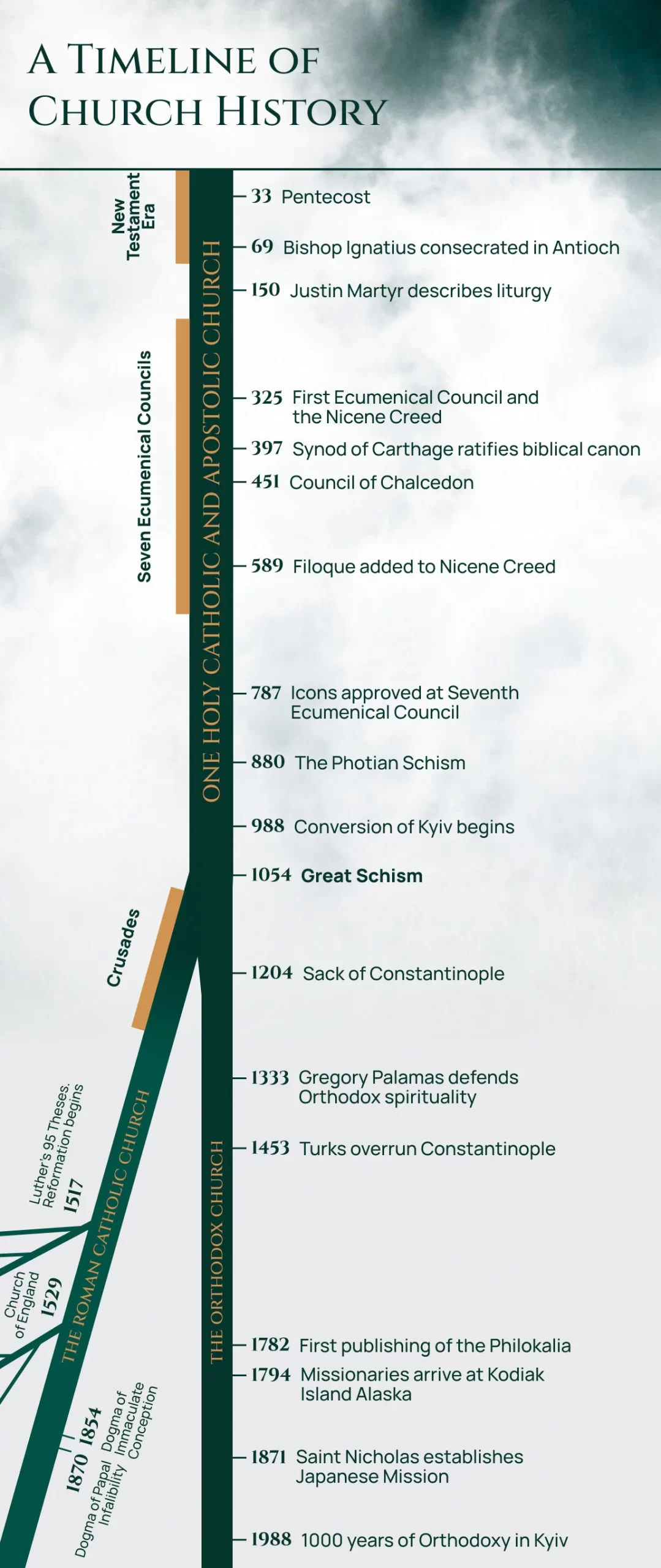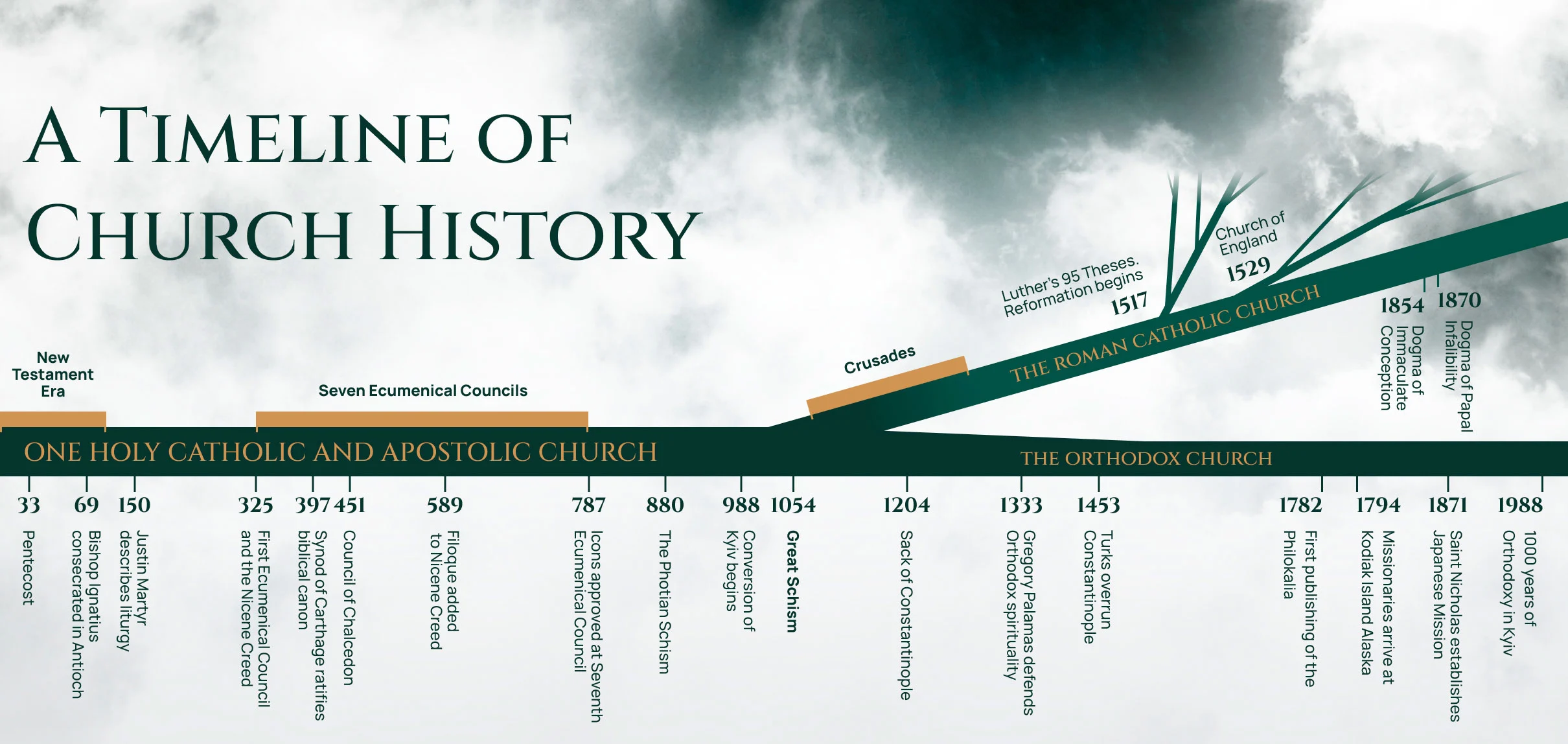This Time Line of Church History has been reproduced with permission from Conciliar Press, © Copyright 1988 Conciliar Press; Second Edition 1989). The links and some additions have been added by St. Ignatius of Antioch Orthodox Christian Church.
The following timeline and associated text provided further below are intended to provide the reader with a general and simplified overview of the development of the Christian Church.
For a more detailed description of the history of the church, the reader is encouraged to read The Byzantine Legacy in the Orthodox Church by Fr. John Meyendorff and Rome-Constantinople-Moscow Historical and Theological Studies also by Fr. John Meyendorff. The first chapter in the latter reference begins with the following paragraph:
All historians agree today that the schism which eventually became a permanent form of separation between Eastern and Western Christians did not occur suddenly. It was the result of a progressive “estrangement” (the English term used by the French theologian Yves Congar), and cannot even be dated.
The churches of Rome and Constantinople were often separated for long periods of time already between the fourth and the ninth centuries. Those early conflicts were sometimes caused by heresies, held in the capital of the Eastern empire (Arianism, 335-381; Monotheletism, 533-680; Iconoclasm, 723-787; 815-842) and rightfully rejected by Rome. Sometimes Rome and Constantinople differed in their attitude in the field of ecclesiastical oikonomia (the “Neo-Nicean” position, inherited from the Cappadocian Fathers, 381-ca. 400; the attitude to be adopted towards the Henotikon, also referred to as the “Acacian schism”, 482-518), and communication was broken on those grounds.
Whatever the issue and whoever was at fault, it is clear that, underneath the debate on a concrete theological or disciplinary problem, there was a developing difference in the respective authority of the “apostolic see” of Rome on the one side, and on the other, the idea of a conciliar consensus prevailing in the East.


33 — Pentecost (A.D: 29 is thought to be more accurate).
49 — Council at Jerusalem (Acts 15) establishes precedent for addressing Church disputes in Council. James presides as bishop.
69 — Bishop Ignatius consecrated in Antioch in heart of New Testament era–St. Peter had been the first bishop there. Other early bishops include James, Polycarp, and Clement.
95 — Book of Revelation written, probably the last of the New Testament books.
150 — St. Justin Martyr describe’s the liturgical worship of the Church, centered in the Eucharist. Liturgical worship is rooted in both the Old and New Testament.
325 — The Nicene Creed is established. The Council of Nicea settles the major heretical challenge to the Christian faith when the heretic Arius asserts Christ was created by the Father. St. Athanasius defends the eternality of the Son of God. The Arians continue their assault on true Christianity for years. Nicea is the first of Seven Ecumenical (Church-wide) Councils.
451 — Council of Chalcedon affirms apostolic doctrine of two natures in Christ.
589 — In a synod in Toledo, Spain, the filioque, asserting that the Holy Spirit procedes from the Father and the Son is added to the Nicene Creed. This error is later adopted by Rome.
787 — The era of Ecumenical Councils ends at Nicea, with the Seventh Council bringing the centuries-old use of icons back into the Church.
988 — Conversion of Kyiv and Kyiv Rus begins.
1054 — The Great Schism occurs. Two major issues include Rome’s claim to a universal papal supremacy and her addition of the filioque clause to the Nicene Creed. The Photian schism (880) further complicated the debate.
1095 — The Crusades begun by the Roman Church. The Sack of Constantinople by Rome (1204) adds to the estrangement between East and West.
1333 — St. Gregory Palamas defends the Orthodox practice of hesychast spirituality and the use of the Jesus prayer.
1453 — Turks overrun Constantinople; Byzantine Empire ends.
1517 — Martin Luther nails his 95 Theses to the door of the Roman Church in Wittenberg, starting the Protestant Reformation.
1529 — Church of England begins pulling away from Rome.
1794 — Missionaries arrive on Kodiak Island in Alaska; Orthodoxy introduced to North America.
1854 — Rome establishes the Immaculate Conception dogma.
1870 — Papal Infallibility becomes Roman dogma.
1988 — One thousand years of Orthodoxy in Kyiv, as the Orthodox Church worldwide maintains the fulness of the Apostolic faith.
A Word About Church History
Scholars estimate there are over 2600 groups today who lay claim to being the Church, or at least the direct descendants of the Church described in the New Testament. Repeat: 2600!
But for the first thousand years of her history the Church was essentially one. Five historic Patriarchal centers–Jerusalem; Antioch, Rome, Alexandria, and Constantinople– formed a cohesive whole and were in full communion with each other. There were occasional heretical or schismatic groups going their own way, to be sure; but the Church was unified until the 11th century. Then, in events culminating in A.D.1054, the Roman Patriarch pulled away from the other four, pursuing his long-developing claim of universal headship of the Church.
Today, nearly a thousand years later, the other four Patriarchates remain intact, in full communion, maintaining that Orthodox apostolic faith of the inspired New Testament record. The Orthodox Church and her history is described herein, from Pentecost to the present day.